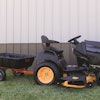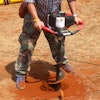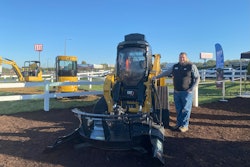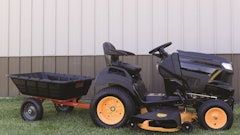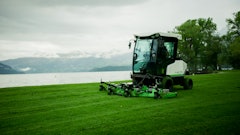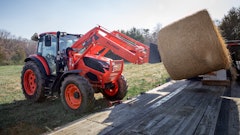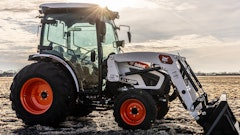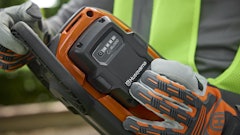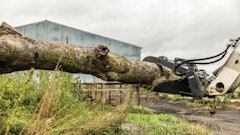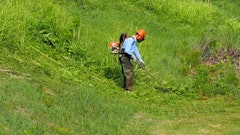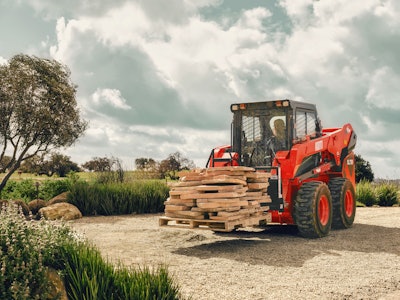
As the demand increases for economical solutions to save money on labor, repair costs and machine downtime, compact equipment and associated attachments have become more prevalent as well, says Keith Huff, implement and attachment product line manager Kioti Tractor.
The equipment enables landscape pros to increase accessibility, improve efficiency and increase overall profitability.
“Operators can get into more confined spaces without doing damage to the lawn or surface area they come in contact with,” Huff says. “By using machines to do the work faster with less labor also improves profitability and enables growth by being able to scale their business. With a wide range of attachments available, contractors can take on a variety of new jobs and increase their customer base and profitability.”
Frank Gangi, product manager for wheel loaders and attachments, Yanmar Compact Equipment North America, agrees.
“Compact equipment is essential for landscapers, allowing them to do more with less,” Gangi says. “Attachments allow compact equipment to take on multiple steps of the process for a variety of jobs. (For example), on a mini excavator, you can run a mulcher or brush mower for land clearing and cleaning, then switch to a bucket with a thumb to move and place logs, brush and rocks. Compact track loaders can use a mulcher or brush mower to tear down brush during land clearing, then use a grapple rake to move brush and large rocks before finally equipping a soil conditioner to finish preparing the soil.”
Popular attachments
According to the experts, attachments that have increased in popularity include:
· Buckets for moving materials, excavation and grading
· Pallet forks for lifting and moving materials
· Grapple rakes and brush mowers for land clearing
· Soil conditioners for seed bed and lawn preparation
· Stump grinders for stump removal
· Brooms to clean sidewalks and driveways and clear snow in winter
· Post hole diggers for setting fences or planting trees
· Forestry mulchers for clearing vegetation
· Log grapples for handling logs and lumber
· Trenchers for installing irrigation and drainage systems
· Blowers, plows and sweepers for snow removal
· Grader blades for exacting finish grade jobs by including technology that allows for precise movement
“Compact equipment can help complete jobs much more efficiently and save labor costs by doing jobs that require intense manual effort,” says Eric Mangum, Caterpillar senior product consultant. “Examples include trenching for water lines or irrigation, excavation for footings or retaining walls and grading for sidewalks or driveways. When a landscaper uses attachments specifically designed to work in these areas and more, they can get more work done in a day and save a tremendous amount of heavy, manual work.”
Huff adds that perhaps the most efficient and versatile attachment is the four-in-one bucket.
“The four-in-one bucket has the capacity to do four different tasks without having to step off the machine,” Huff says. “With the right attachment, you can reduce your labor cost and decrease your time on the job, which both boost your bottom line.”
Before determining what attachments may work well within an operation, Gangi recommends first thinking about their jobsite requirements.
“It’s a good idea to think about what jobs you might want to do as you look at purchasing attachments so you can be ready when the opportunity arises,” Gangi says. “Another good option is to rent an attachment first to see how it works and fits your job application.”
Gangi adds that many attachment manufacturers are offering bigger and smaller options to accommodate the expanding range of equipment in the market.
Maintenance to do’s
One reason the above attachments are so effective, Huff says, is that the maintenance requirements are relatively low.
“The simpler and more effective the attachment can be, the more popular it is among customers,” Huff says. “Aside from some simple grease points, they are easy to maintain. Once you cross over into more dynamic attachments, then more maintenance may be required.”
In addition to handling grease points, Gangi suggests inspecting hydraulic hoses and connections for leaks and wear.
Finally, Mangum recommends adhering to a maintenance manual schedule and visually inspecting the attachment daily for damage or checking ground engaging tools for wear.
What to know
First and foremost, safety is a must.
“Make sure people working on the jobsite are wearing recommended personal protective equipment and educate employees on jobsite safety protocols and communication,” Mangum says. “For the equipment and jobsite, perform walkarounds and inspections of the equipment and identify ahead of time low handing power lines, underground utilities and dedicated walking areas.”
Also, operators should be sure to read the owner’s manual before use.
“Proper training and adherence to the machine’s safety guidelines must always be followed,” Huff says.
Gangi adds that operators should be sure to have proper guarding any time they are mulching or brush mowing and be aware of their surroundings for property and people.
“Always examine the worksite and conditions for hazards that could be potential safety concerns for any job,” Gangi says.
What’s trending
Moving forward, Gangi says the industry will see more communication technologies between attachments and machines, including some integration with the onboard display.
Mangum agrees.
“Technology is becoming increasingly common in landscape applications. Owners and operators are embracing GPS, laser systems and sonar for precise work,” Mangum says. “Not only does the technology help save time and money, but it also enables less experienced operators to quickly pick up skills that increase their efficiency.”

